
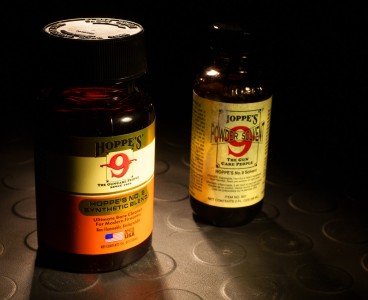
Hoppe’s has introduced a new synthetic blend of its No. 9 and it still has that scent so beloved by generations of gun owners.
By Guy J. Sagi
Hoppe’s
www.hoppes.com
If you’re a gun enthusiast, odds are good you’ve either used or are using Hoppe’s No. 9 Solvent, but did you know it’s considered a “hazmat” material? You can’t send it airmail, probably one of the reasons Hoppe’s No. 9 Synthetic Blend was introduced in January, billed by the company as a non-flammable, polymer-friendly and biodegradable version. The new mix doesn’t fall under airline “hazmat” guidelines, so you can get it a day sooner, but other than that it was hard to identify any other tangible benefits during testing. And, unlike Internet rumors of its dangers, the classic version of No. 9 didn’t harm a polymer handgun and it even seemed unable to burn through a thin-walled garbage bag.
Dozens of new cleaning solutions are rolled out every year, but anything bearing the Hoppe’s name deserves close examination, so we conducted a series of head-to-head tests with some surprising results.
Frank A. Hoppe developed Hoppe’s No. 9 in 1903, at a time when the firearms industry and shooters were finally coming to grips with the fact that this relatively new smokeless powder, which was thought to be so clean, produced residue that stubbornly defied most traditional cleaning solutions. One hundred and ten years later, generations of shooting enthusiasts consider its performance unsurpassed and that familiar scent carries with it an air of romance. The first test was passed with flying colors when the aroma escaping from the bottle had Hoppe’s written all over it.
Although the original Hoppe’s No. 9 was never really designed to attack rust, it does an amazing job with enough patience, and that’s where the side-by-side comparison to photographically catalog any difference in performance began.
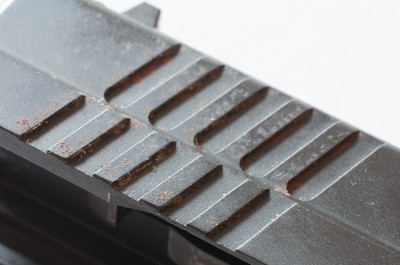
Here’s a look at the slide before multiple applications of Hoppe’s No. 9 Solvent. Click on each image to enlarge for a closer look at the progess.
After removing the slide from a polymer handgun (remember, some claim the original Hoppe’s No. 9 Solvent doesn’t play well with polymer), the rust and grime accumulated in the rear serrations of the slide were targeted by both versions of Hoppe’s. With two sides, one for each formula, and an ugly mess evident under the macro lens, the stage was set.
Photos of the serrations were taken in the hopes of providing a baseline reference to determine the victor. One end of a Q-tip was then dipped in the original formula and used to soak the serrations on one side of the slide. After a 15-minute wait, the other, uncontaminated end of the Q-tip was rubbed back and forth to dry the slide and remove grime. That was followed by a rag to fully remove debris and moisture, and another picture. The difference was noticeable, but far from acceptable.
Here’s a gun-cleaning rule that’s far too easy to violate, especially during these trying economic times. It may be tempting to insert a relatively clean-looking dry or wet cleaning patch into the solvent after you’ve run it through the bore, but don’t do it. Any carbon, lead and copper it has picked along the way, whether visible or not, will hit the chemical, immediately go into suspension (or bond with the solution) in the bottle, and sooner or later that bore cleaner turns into nothing more than a lead, carbon and copper soup. Keep it sterile and your gun-cleaning chores will remain efficient for months to come. The same goes for Q-tips used to reach those tight spots. In this case, one end went in the bottle, the other dry end was used to scrub and then it was thrown away. Many people avoid soaking bore brushes for the same reason, although some do so.
Finally, a second coat went onto the slide and into the serrations, again soaking 15 minutes. Once cleaned, dried and photographed, the difference was huge, but that’s the beauty of original Hoppe’s No. 9 Solvent, you apply, scrub and repeat until clean.
Turning the slide over to its untouched side, an identical, two-soaking methodology was employed with the new Hoppe’s No. 9 Synthetic Blend. Once done, it appeared the original solution did slightly better in attacking this easily photographed nuisance (take a look at the images and you can decide). But, rust isn’t where either of these formulas really shine.
To determine which solution performed best on the relatively hidden recesses of a barrel, tests were run on two dirty handguns. In the interest of full disclosure, the classic formula scrubbed a 9 mm barrel, the synthetic version tackled a .45 ACP.
Here’s a couple other important safety tips to remember when cleaning your guns. ALWAYS, check, double check and triple check that your firearm is unloaded and the magazine (if it has one) is removed. In anything and everything you do in firearms, safety is foremost and your responsibility. Wear eye protection. Yes, the gun’s “safe,” but every time that wire brush comes out of the muzzle chemicals will be flying as the brush expands. Getting Hoppe’s or any chemical in your eyes is not a pleasant experience. Whether you’re doing this in a garage or even in the yard, put newspapers or some sort of covering under your workspace. AND, wash your hands and face well after each cleaning session. Remember, lead is among the things being removed from the barrel, and it will get on your fingers as you push rods through, change patches or even on your face when you get splattered. Simple soap and water handles the situation with ease.
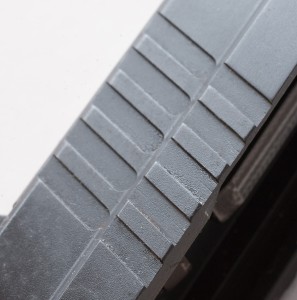
After another drying, you can see how the original solvent really worked its way under the handgun’s crud.
To protect the crown of your barrel, on a semi-automatic handgun, it is always best to field strip the pistol and push your cleaning rod or brush from the chamber side. Doing otherwise increases the chances of dings and scratches being created at the very end of the rifling, which is the last point a bullet touches on the gun. If that happens, accuracy could be compromised.
After five wet patches with the Hoppe’s No. 9 Solvent were run through the barrel, each followed by a bore brush once things soaked for 15 minutes, things were coming out pretty clean. A dry patch was then passed through the bore, followed by one final patch soaked in the classic. After 15 minutes, a dry patch came out clean.
A patch soaked with the new Synthetic Blend was then passed through the bore, with the solution allowed another 15 minutes to loosen any fouling that might have been missed by No. 9 Solvent. The follow-up dry patch came out clean.
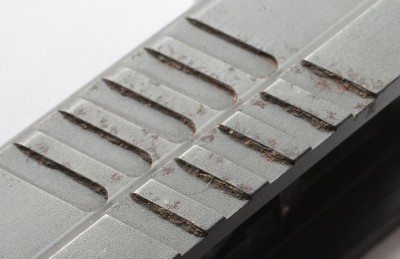
To see if the new Hoppe’s No. 9 Synthetic Blend was just as effective, the slide was turned over and work began on serrations there. Here’s a look at what it looked like before application.
At this point, we knew either the bore was scrubbed completely clean by the Hoppe’s No. 9 Solvent (original), or anything that remained was too stingy for the new formula to remove.
To solve that riddle, the .45 ACP barrel was attacked with patches soaked with the Synthetic Blend, followed by bore brushing. Employing exactly the same methodology throughout, this session ended with a patch soaked in the classic formula. If the next dry patch came out with any fouling, then the new version is less powerful than its predecessor. After 15 minutes, the dry patch came out spic and span.
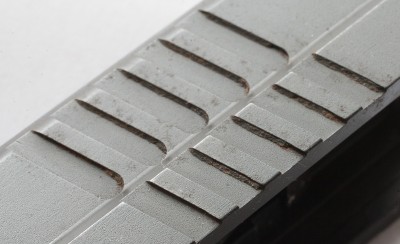
After two soakings with Hoppe’s No. 9 Synthetic Blend and light scrubbing with a Q-tip, this is how the serrations looked.
The effort was far from scientific, but in regard to cleaning your barrel it appears the new formula is every bit as effective as the original. Externally, however, the Synthetic Blend did appear to be a little less aggressive on the dirt and rust on the slide’s serrations. Perhaps things were stingier on the side targeted by the new formula, but the photographic evidence seems to support the claim that it didn’t quite get things as clean.
The original formula appears a little darker on the patches, and the aroma is slightly stronger than that of the new blend. Some claim Hoppe’s helps protect the gun after cleaning, but it’s smart to ignore the rumors and shade-tree advice by applying a thin coat of oil to help prevent rust. Then, follow the manufacturer’s directions as to where a few extra drops of oil may be needed to ensure proper function—slide rails, etc.
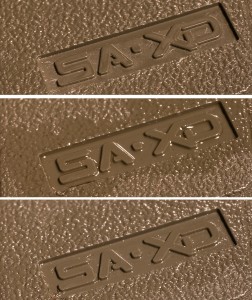
To determine if the original formula actually harmed a polymer handgun frame, the logo on the grips of a Springfield XD (top) was targeted and a photo taken to document it prior to testing. Then a liberal amount of Hoppe’s No. 9 Solvent was applied and allowed to soak 3 hours (middle). When cleaned with a Q-tip, the polymer was firm and unscarred. The slight darkening was where the Hoppe’s apparently evaporated and it cleaned up intantly with soap and water.
Hoppe’s No. 9 Synthetic Blend is also claimed to be safe for rubber, anodized aluminum, titanium and most of the materials used in the manufacture of modern firearms. The claim it’s safe for polymer frames infers the original Hoppe’s may not be, which can be easily tested.
To do so, a liberal amount of Hoppe’s No. 9 Solvent was applied to the logo on the grips of a Springfield XD. The recessed portion served nicely, holding enough of the solution to slighly pool.
Three hours later the Hoppe’s had evaporated (72 degrees) and left a slightly dark residue. The grips looked the same and with soap and water the slight discoloration where it had dried was gone. Maybe it takes a higher temperature to produce damage, or perhaps the results would have been different with another gun’s polymer composition. It certainly isn’t recommended that anyone give this a try, but 3 hours is pretty extreme, so the experiment certainly allies fears in regard to the original formula’s cautious use on polymer guns. Even pooled on a thin plastic garbage bag, after an hour of soaking, Hoppe’s No. 9 Solvent hadn’t torn a hole or even thinned it noticeably.
Hoppe’s No. 9 Solvent does burn, although with little ferocity. It was more like one of those Citronella oil torches you use for backyard barbecues. The Synthetic Blend refused to ignite, despite multiple attempts.

Where both Hoppe’s formulas really shine is in cleaning barrels. In testing they seemed to perform equally well.
Hoppe’s No. 9 Synthetic Blend is made in the United States and MSRP for 2-ounce bottles is $4.95. That’s a little more expensive than the original. If you go through a lot, 1-gallon jugs of the new version will cost you a C-note. If you order the new formula it can be shipped by air, which is not the case with the classic version.
Both are great for post-range-session cleanup, come with that hypnotizing Hoppe’s scent and, apparently, neither chew on polymer. If you’re concerned about flammable materials or need bore cleaner, yesterday, then Hoppe’s No. 9 Synthetic Blend may be your best choice. Otherwise, most shooters will probably be just as happy with the tried-and-true, 110-year-old version. It’s hard to beat a classic.
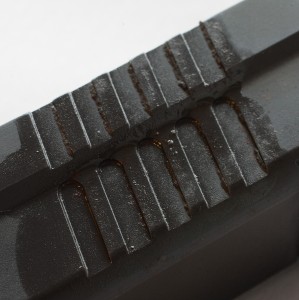
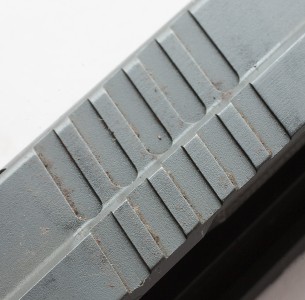
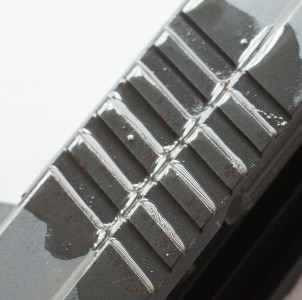
I`m looking for tips on how to remove lead and/or fouling of the forcing cone area of a revolver.
I`m looking for tips on how to remove lead and/or fouling of the forcing cone area of a revolver.
Dear bhp9,
Actually I think the older, original Hoppe’s No 9 had nitrobenzene in it.
That old stuff was the best! It would remove crud, powder residue, and, even copper.
Sincerely
Ronnie
The original Hoppe’s #9 contained nitrobenzene which is a primary carcinogen. Bad stuff. Worked good but really bad for your internal organs. I worked in analytical chemistry for 37 years and when MSDS and RTK laws went into effect we were not allowed to have it in the lab anymore. The replacement #9 did not do anywhere near as good a job. The easiest and cheapest way to clean non-jacket fouling (powder residue) is to use VMP Naptha (lighter fluid) which is available at all paint and hardware stores as well as Lowes and Home Depot and is a fraction of the cost of Hoppe’s. If you use Sweets, Barnes or Shooters Choice you should not leave the stuff in a barrel more than 15-20 minutes as it will chemically attack the metal. They work really well for copper fouling but be careful with the stuff.
I never had a problem with No. 9 on plastics, but I once dripped some on the anodized alloy gripframe on my Single-Six and it removed the black finish.
Thanks for that info, Skip, I’ll use my new heated ultrasonic cleaner with the heater turned on for some parts. It’s good to know that the heat makes such a difference. I have many tools that could use a heated ultrasonic cleaner, for example airbrush parts.
I told my wife that instead of expensive perfume to put a drop of Hoppe’s behind each ear if she really wanted to get my attention. She was not amused. I traded her in for a pair of pistols.
For what it’s worth, we use Hoppes in a heated, ultrasonic bath to clean aircraft fuel injector nozzles. We heat the stuff to 80° C and run the vibratory unit for 30 minutes.Never had a fire and the injectors come out shiny as new.
First of all the original Hoppe’s was discontinued decades ago because it contained the cancer causing chemical Benzene. Hoppe’s No. 9 second generation did not have benzene in it but was less effective too. You do not get something for nothing. This new synthetic formula which according to your tests is inferior is now the 3rd generation solvent.
Also another misconception is that Hoppe’s Bench Rest Sovent is more aggresive than the second generation standard Hopp’es No. 9. Not true, Bench rest solvent is much milder to prevent any bore ethching if left in the bore too long. Doubt my word? Take some Hoppe’s no. 9 and some Bench Rest solvent and put them on two pennies and see how long it takes both solvent to start to clean up the old tarnished pennies. Bench rest takes twice as long because it is much milder.
Maybe they’ll make an all natural Gen 4 from GMO corn. Now we’re talking benzene!
Hoppes, used it for years, but tried G96 gun treatment… and I’m hooked. Great stuff!
Glad to hear this stuff works. I’ve used other “eco-friendly” cleaners like bike chain solvent that turned out to be lacking.